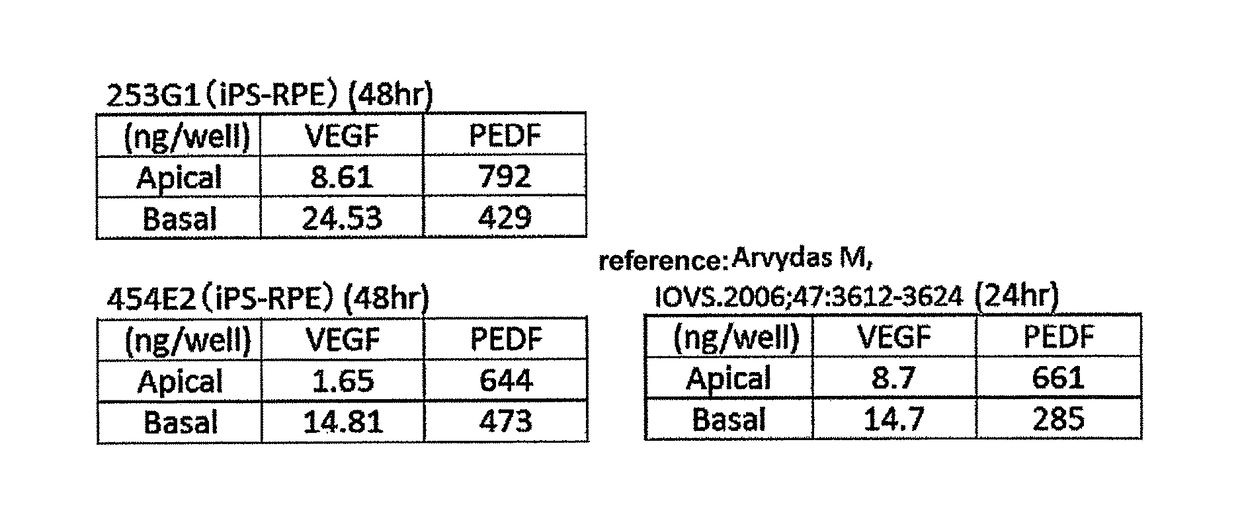Method of producing retinal pigment epithelial cell sheet
a cell sheet and retinal pigment technology, applied in the field of cell sheet production, can solve the problems of poor engraftment of transplanted cells, inability to provide therapeutic effect for exudative or atrophic forms, and high risk of surgery, and achieves superior engraftment rate and function, convenient transplantation, and easy preparation and stably.
- Summary
- Abstract
- Description
- Claims
- Application Information
AI Technical Summary
Benefits of technology
Problems solved by technology
Method used
Image
Examples
production example 1
Preparation of Retinal Pigment Epithelial Cells
[0073]As the retinal pigment epithelial cells to be used for sheeting in the following Example 1, used were mature retinal pigment epithelial cells (253G1, K11PD2, 59M8, 59SV2, 59SV3, 59SV9, 46a, K21EV15, 101EV3, K11EV9, 454E2) obtained by inducing differentiation of iPS cell, and retinal pigment epithelial cells (hES, CMK6) obtained by inducing differentiation of ES cell, according to the method described in Neuroscience Letters 458 (2009) 126-131.
[0074]253G1 is a retinal pigment epithelial cell obtained by inducing differentiation of human iPS cell derived from a healthy human, and K11PD2 and 59M8 are retinal pigment epithelial cells induced to differentiate from human iPS cells derived from retinitis pigmentosa patients different from each other. The iPS cell were established by a method including introducing Oct3 / 4, Sox2, Klf4 and c-Myc genes into human skin-derived fibroblasts using retrovirus, according to the method described in ...
example 1
Production Method of Retinal Pigment Epithelial Cell Sheet
[0079]A: Swine tendon-derived acid-soluble Type-I collagen Cellmatrix I-A (Nitta Gelatin, 3.0 mg / ml), B: concentrated culture medium at 5-fold concentration [DMEM / F12 (Invitrogen, 12500-062, 3 g) was dissolved in MilliQ water, and total volume (50 ml) was filter-treated], and C: buffer for reconstitution [1N NaOH (50 mM, 5 ml), NaHCO3 (260 mM, 2.2 g) and HEPES (200 mM, 4.77 g) were dissolved in MilliQ water, and total volume (100 ml) was filter-treated] were prepared. Under cooling, B (2 vol) was mixed (pale-yellow) with A (7 vol) without bubbling. Then, C (1 vol) was added and the mixture was mixed (pale-pink) to give a 0.21% collagen gel mixed solution.
[0080]The 0.21% collagen gel mixed solution (200 μl) was added into the insert of a 12 mm transwell insert (0.4 μm Pore Polyester membrane; Cornig, 3460), and the mixture was incubated at 37° C. for 30 min. Then, F10-10% FBS [F-10 (Sigma, N6908, 445 ml), FBS (50 ml), Penicili...
example 2
Production Method of Retinal Pigment Epithelial Cell Sheet (Kind of Collagen)
[0082]In the same manner as in Example 1 except that, in the step of producing a cell sheet using 253G1 (iPS-retinal pigment epithelial cells) in Example 1, (A) swine skin-derived Type-I collagen TE (special order product: mainly containing Type-I collagen, a small quantity of Type-III collagen, Nitta Gelatin, 5 mg / ml) was used as 0.35% collagen mixed solution / well, (B) swine tendon-derived Type-I collagen T-1002 (special order product: Type-I collagen, Nitta Gelatin, 5.1 mg / ml) was used as 0.35% collagen mixed solution / well, (C) FITC-labeled collagen I (Chondrex, 1 mg / ml) was used as 0.07% collagen mixed solution / well, (D) FITC-labeled collagen I (special order, Chondrex, 3 mg / ml) was used as 0.21% collagen mixed solution / well, (E) atelocollagen (KOKEN, 3 mg / ml) was used as 0.21% collagen mixed solution / well, and (F) permeability collagen membrane for cell culture (KOKEN) was used, respectively, instead of...
PUM
| Property | Measurement | Unit |
|---|---|---|
| temperature | aaaaa | aaaaa |
| temperature | aaaaa | aaaaa |
| temperature | aaaaa | aaaaa |
Abstract
Description
Claims
Application Information
 Login to View More
Login to View More - R&D
- Intellectual Property
- Life Sciences
- Materials
- Tech Scout
- Unparalleled Data Quality
- Higher Quality Content
- 60% Fewer Hallucinations
Browse by: Latest US Patents, China's latest patents, Technical Efficacy Thesaurus, Application Domain, Technology Topic, Popular Technical Reports.
© 2025 PatSnap. All rights reserved.Legal|Privacy policy|Modern Slavery Act Transparency Statement|Sitemap|About US| Contact US: help@patsnap.com

